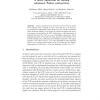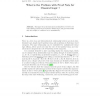109
click to vote
CIE
2010
Springer
15 years 4 months ago
2010
Springer
A binary matrix has the Consecutive Ones Property (C1P) if its columns can be ordered in such a way that all 1s on each row are consecutive. Algorithmic issues of the C1P are centr...
CIE
2010
Springer
15 years 4 months ago
2010
Springer
In the theory of algorithmic randomness, one of the central notions is that of computable randomness. An infinite binary sequence X is computably random if no recursive martingale...
CIE
2010
Springer
15 years 5 months ago
2010
Springer
A useful theorem of Kuˇcera states that given a Martin-L¨of random infinite binary sequence ω and an effectively open set A of measure less than 1, some tail of ω is not in A...
CIE
2010
Springer
15 years 5 months ago
2010
Springer
This paper is an informal (and nonexhaustive) overview over some existing notions of proof nets for classical logic, and gives some hints why they might be considered to be unsatis...
CIE
2010
Springer
15 years 5 months ago
2010
Springer
Abstract. We show that the computational interpretation of full comprehension via two wellknown functional interpretations (dialectica and modified realizability) corresponds to t...
CIE
2010
Springer
15 years 5 months ago
2010
Springer
The Tile Assembly Model is a Turing universal model that Winfree introduced in order to study the nanoscale self-assembly of complex (typically aperiodic) DNA crystals. Winfree ex...
CIE
2010
Springer
15 years 5 months ago
2010
Springer
We develop applications of selection functions to proof theory and computational extraction of witnesses from proofs in classical analysis. The main novelty is a translation of cla...
CIE
2010
Springer
15 years 5 months ago
2010
Springer
CIE
2010
Springer
15 years 5 months ago
2010
Springer
This paper discusses Curry’s work on how to implement the problem of inverse interpolation on the ENIAC (1946) and his subsequent work on developing a theory of program compositi...
CIE
2010
Springer
15 years 5 months ago
2010
Springer



